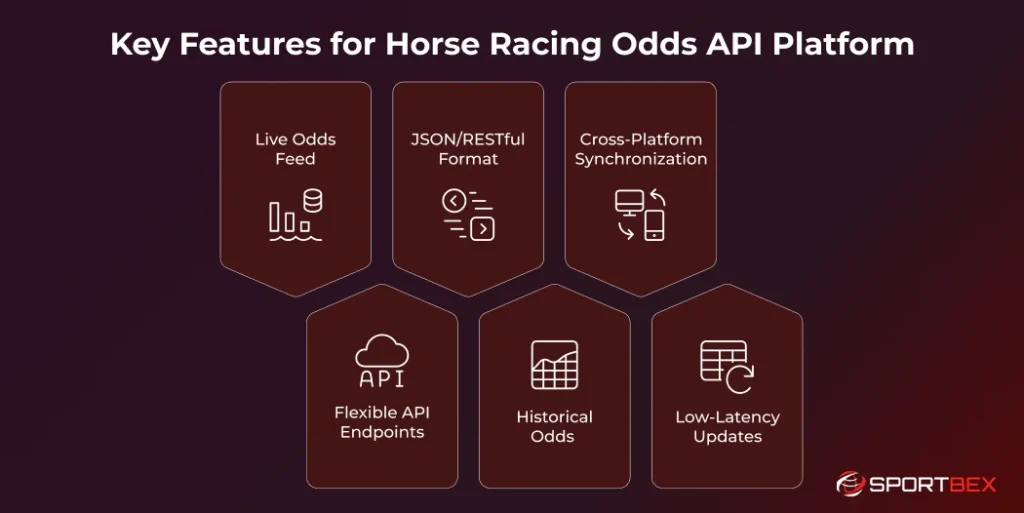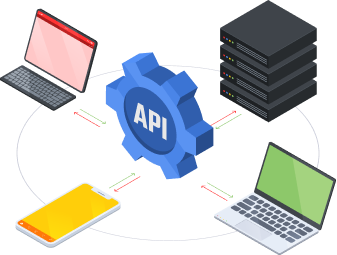Building a successful horse racing platform goes beyond having eye-catching visuals and a sleek, user-friendly interface. At the core of any betting platform is its ability to deliver real-time, accurate odds—the lifeblood that keeps your users engaged and informed.
With horse racing odds constantly fluctuating, having a reliable source of information is crucial for providing users with the most up-to-date insights. That’s where a horse racing API comes in.
It serves as the vital connection between raw, live data and a seamless user experience, transforming complex race data into simple, actionable odds for your platform.
Whether you’re developing a sports betting app, creating a horse racing analytics dashboard, or building a comprehensive racing information portal, knowing how to use a Horse Racing Odds API for your platform can dramatically enhance your platform’s value proposition.
Integrating a reliable betting odds API not only delivers real-time data but also improves user engagement, accuracy, and overall betting experience.
What is a Horse Racing Odds API?
A horse racing odds API is a software intermediary that allows your platform to access real-time and historical horse racing data from external providers. Think of it as a direct pipeline that delivers structured racing information—including odds, race schedules, horse statistics, and results—directly to your application.
Unlike older, complicated data feeds, a modern horse racing odds API uses standard formats like REST and JSON, making integration fast and straightforward. Your development team can easily connect to real-time racing data without the need to build complex systems or expensive infrastructure from scratch.
The API pulls information from multiple sources, including racetracks, official racing organizations, and bookmakers, then standardizes this data into a format your platform can easily consume. This process happens continuously, ensuring your users always have access to the most current information available.
Why Your Platform Needs a Horse Racing Odds API
The horse racing industry moves at lightning speed, with odds fluctuating constantly based on betting patterns, weather conditions, and late-breaking news. Manual data entry or periodic updates simply can’t keep pace with these rapid changes.
A live Sports odds API provides several crucial advantages for your platform. First, it ensures data accuracy and consistency across all racing events. Rather than relying on multiple disparate sources that might contain conflicting information, an API provides a single source of truth for all your racing data needs.
Real-time updates create a more engaging user experience. Users expect to see odds changes as they happen, not minutes or hours later. A live odds API enables this immediacy, keeping users actively engaged with your platform rather than seeking more current information elsewhere.
Capability becomes effortless when you’re working with a robust API. As your platform grows and attracts more users, the API can handle increased data requests without requiring infrastructure changes on your end. This flexibility allows you to focus on improving user experience rather than managing data logistics.
Key Features for Horse Racing Odds API Platform

Key features of a horse racing odds API platform include live odds updates, global race data, flexible endpoints, and easy RESTful integration
Live Odds Feed
The cornerstone of any effective horse racing odds API is its ability to provide real-time odds updates. A quality live odds API should deliver changes within seconds of when they occur at the source. This means your platform can display odds movements as they happen, giving users the most current information for their decision-making process.
Look for APIs that offer granular live horse racing odds data, including win, place, show, exacta, trifecta, and superfecta betting options. The more comprehensive the odds coverage, the more valuable your platform becomes to serious racing enthusiasts.
Flexible API Endpoints
Different sections of your platform will require different types of data. A well-designed horse racing API should offer multiple endpoints that allow you to request specific information without unnecessary data overhead. Common endpoints include race schedules, horse profiles, jockey statistics, track conditions, and historical performance data.
This flexibility ensures your platform can load quickly while still providing comprehensive information. Users browsing upcoming races don’t need detailed historical statistics, while those researching specific horses want access to complete performance records.
JSON/RESTful Format
Modern web applications expect data in easily parseable formats. A quality betting odds API should deliver information in JSON format through a RESTful architecture. This standardization makes integration smoother and reduces development time significantly.
JSON formatting also ensures compatibility with virtually any programming language or framework your development team might be using, from JavaScript and Python to PHP and Ruby.
Historical Odds Data
While live odds grab immediate attention, historical odds data provides the foundation for sophisticated analysis features. Users want to understand odds trends, track betting patterns, and analyze historical performance before making informed decisions.
A comprehensive horse racing odds API should maintain extensive historical records, allowing your platform to offer features like odds comparison charts, trend analysis, and predictive modeling.
Cross-Platform Synchronization
Your users will likely access your platform from a variety of devices—whether it’s a desktop computer, mobile phone, tablet, or even a smartwatch. To make sure they have a smooth experience, your platform needs to stay in sync across all these devices.
That’s where a robust horse racing API integration comes into play. A high-quality API should ensure that your users see consistent, up-to-date information no matter which device they use.
This synchronization extends beyond just odds data to include user preferences, betting history, and personalized notifications across all devices.
Low-Latency Updates
In horse racing, seconds matter. A delayed odds update could mean the difference between a profitable bet and a missed opportunity. Quality APIs prioritize low-latency updates, typically delivering new information within seconds of when changes occur.
This speed requirement makes technical architecture crucial. Look for APIs that use efficient data transmission protocols and maintain robust server infrastructure to handle high-frequency updates without interruption.
Step-by-Step Guide to Using a Horse Racing Odds API
Learn how to integrate and use a horse racing odds API step by step to deliver real-time betting data and enhance your platform’s performance
Choose the Best API Provider
Selecting the right API provider forms the foundation of your entire integration project. Research providers based on data coverage, update frequency, reliability, and pricing structure. Consider factors like geographical coverage—some providers excel in North American racing, while others are better suited for international horse racing app platforms.
Evaluate each provider’s documentation quality, customer support responsiveness, and track record with similar platforms. Read case studies and customer testimonials to understand real-world performance under various conditions.
Getting API Access
Most reputable providers offer tiered access plans, from basic free tiers for testing to enterprise-level subscriptions for high-volume platforms. Begin with a developer account that allows you to explore the API’s capabilities without committing to a full subscription.
The registration process typically involves creating an account, verifying your business details, and receiving API credentials—usually an API key and secret token. Store these credentials securely, as they’ll be required for all API requests.
API Documentation Overview
Before writing any code, thoroughly review the API documentation. Quality providers offer comprehensive guides that include endpoint descriptions, parameter explanations, response format examples, and error handling procedures.
Pay particular attention to rate limiting information, authentication requirements, and data refresh schedules. Understanding these constraints upfront prevents integration issues later in the development process.
Set Up API Connection
Establish a secure connection to the API using your preferred programming language. Most modern APIs use HTTPS protocols with API key authentication. Here’s a basic example structure:
Create a connection class that handles authentication, request formatting, and response parsing. Include error handling for common issues like network timeouts, invalid requests, and exceeded rate limits.
Implement caching mechanisms to reduce API calls and improve platform performance. Cache frequently requested data like race schedules and horse profiles while ensuring live odds remain current.
Show Live Odds
Design your platform’s interface to display odds information clearly and attractively. Consider using visual indicators for odds changes—green for improving odds, red for declining odds, and neutral colors for stable prices.
Implement real-time updates using WebSocket connections or periodic polling, depending on your odds API provider’s supported methods. Ensure updates appear smoothly without jarring page refreshes that disrupt the user experience.
Handle Mistakes Well
Robust error handling separates professional platforms from amateur attempts. Implement comprehensive error catching for various scenarios: API server downtime, invalid responses, network connectivity issues, and exceeded quota limits.
Create fallback mechanisms that maintain platform functionality even when API services experience temporary interruptions. This might include serving cached data with appropriate timestamps or displaying maintenance messages with estimated resolution times.
Test, Track, Improve
Develop a comprehensive testing strategy that covers normal operations, edge cases, and failure scenarios. Use both automated testing tools and manual testing procedures to ensure reliability under various conditions.
Monitor API performance metrics including response times, error rates, and data accuracy. Many providers offer analytics dashboards that help identify patterns and optimize your integration over time.
Go Live with Odds
Deploy your integration gradually, starting with a subset of users or racing events. Monitor system performance closely during initial launch phases, watching for unexpected load patterns or integration issues.
Establish monitoring and alerting systems that notify your team immediately if API connectivity or data quality issues arise. Quick response times to problems maintain user trust and platform reputation.
Get a Ready-Made Platform On Rent.
Get Started Today
Conclusion
Integrating a horse racing odds API into your platform can take user experience to the next level. With real-time data, customizable endpoints, and cross-platform syncing, users can enjoy accurate and timely race information no matter how they access your platform.
Whether you’re developing a sports betting app, a fantasy sports app, a racing analytics dashboard, or a comprehensive race portal, the right API keeps your platform fast, reliable, and easy to use.
By integrating the right tools and following the proper steps, you can offer a dynamic, engaging experience that boosts user retention and sets your platform apart in the competitive worlds of horse racing and fantasy sports.
Frequently Asked Questions
A Horse Racing Odds API provides real-time race data and betting odds, allowing you to integrate it into your platform for live updates.
Odds are updated live — typically every few seconds — to reflect real-time changes in the betting market.
It provides real-time odds, boosts user engagement, ensures accuracy, and automates the update process, saving you time and resources.
The Horse Racing API provides real-time odds, accurate data, and seamless integration to enhance user engagement and the betting experience.
Most APIs offer global coverage, including races in the UK, US, Australia, Ireland, and more.
Recent Blog
Build Your Own Horse Racing Odds Tracker with Our API
July 18, 2025
 10 min
10 min
Top 10 Famous Tennis Players in India
July 18, 2025
 8 min
8 min







